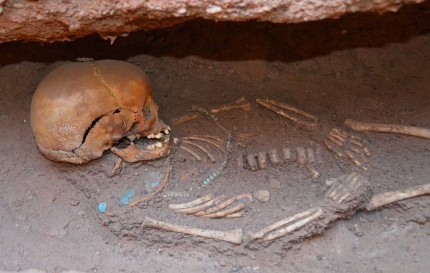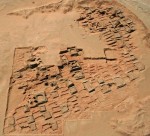 Researchers have discovered the remains of 35 pyramids clustered together in surprisingly close quarters in the archaeological site of Sedeinga on the left bank of the Nile in Sudan. The entire site is huge, covering more than 30 hectares, and has a range of monuments from the temple of Queen Tiye, wife of Amenhotep III, built in the second half of the 14th century B.C. to a 10th century A.D. Christian church.
Researchers have discovered the remains of 35 pyramids clustered together in surprisingly close quarters in the archaeological site of Sedeinga on the left bank of the Nile in Sudan. The entire site is huge, covering more than 30 hectares, and has a range of monuments from the temple of Queen Tiye, wife of Amenhotep III, built in the second half of the 14th century B.C. to a 10th century A.D. Christian church.
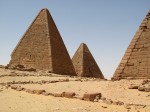 In Amenhotep’s day, Sedeinga was in the Egyptian colony of Nubia but it became part of the independent Kingdom of Kush after the collapse of Egypt’s New Kingdom in 1070 B.C. The first 500 years or so of the kingdom is known as the Napatan (after Napata, which may have been the capital during this period) during which Egyptian hieroglyphics were used in inscriptions. From 500 B.C. through to around the 2nd century A.D. when the Kingdom declined under Roman pressure, the period is known as the Meroitic (after Meroë, possibly the new capital) as is the writing system that developed from the 2nd century B.C. on.
In Amenhotep’s day, Sedeinga was in the Egyptian colony of Nubia but it became part of the independent Kingdom of Kush after the collapse of Egypt’s New Kingdom in 1070 B.C. The first 500 years or so of the kingdom is known as the Napatan (after Napata, which may have been the capital during this period) during which Egyptian hieroglyphics were used in inscriptions. From 500 B.C. through to around the 2nd century A.D. when the Kingdom declined under Roman pressure, the period is known as the Meroitic (after Meroë, possibly the new capital) as is the writing system that developed from the 2nd century B.C. on.
 It’s the late Meroitic necropolis that the French Archaeological Mission to Sedeinga has been excavating since 2009. The pyramids were built over the course of several centuries with tombs next to them. They are so densely packed together because when the space began to fill up, later pyramids were squeezled in between and older ones reused. Just to give you an idea of how tight these quarters were, in the 2011 field season, researchers found 13 pyramids rubbing shoulders in 5,381 square feet, a space only slightly larger than an NBA basketball court.
It’s the late Meroitic necropolis that the French Archaeological Mission to Sedeinga has been excavating since 2009. The pyramids were built over the course of several centuries with tombs next to them. They are so densely packed together because when the space began to fill up, later pyramids were squeezled in between and older ones reused. Just to give you an idea of how tight these quarters were, in the 2011 field season, researchers found 13 pyramids rubbing shoulders in 5,381 square feet, a space only slightly larger than an NBA basketball court.
The biggest pyramids they discovered are about 22 feet (7 meters) wide at their base with the smallest example, likely constructed for the burial of a child, being only 30 inches (750 millimeters) long. The tops of the pyramids are not attached, as the passage of time and the presence of a camel caravan route resulted in damage to the monuments. [Excavation director Vincent] Francigny said that the tops would have been decorated with a capstone depicting either a bird or a lotus flower on top of a solar orb.
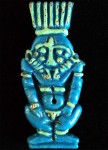 Capstones have been discovered on the site, as have artifacts and human remains. Faience amulets depicting the deity Bes and an ankh on a crescent moon, pottery, beads and shells that were once strung together to make jewelry, a copper bowl, a stela with a Meroitic inscription and an offering table with a Meroitic dedication to a woman named “Aba-la,” which may be a nickname for “grandmother” (abuela!). The translation reads:
Capstones have been discovered on the site, as have artifacts and human remains. Faience amulets depicting the deity Bes and an ankh on a crescent moon, pottery, beads and shells that were once strung together to make jewelry, a copper bowl, a stela with a Meroitic inscription and an offering table with a Meroitic dedication to a woman named “Aba-la,” which may be a nickname for “grandmother” (abuela!). The translation reads:
Oh Isis! Oh Osiris!
It is Aba-la.
Make her drink plentiful water;
Make her eat plentiful bread;
Make her be served a good meal.
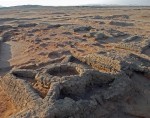 The Kingdom of Kush borrowed a lot from Egyptian culture, which makes sense given its roots as an Egyptian colony. They worshiped the Egyptian pantheon and obviously their funerary architecture was inspired by Egypt. The Kush pyramids are smaller and pointier and several of the pyramid bases discovered in Sedeinga have an unusual circular structure inset within the square with cross-braces connecting the circle to the corners. Outside of Sedeinga, only one other pyramid has been found discovered with this circular element. There’s no equivalent in Egyptian architecture and there’s no structural purpose to it.
The Kingdom of Kush borrowed a lot from Egyptian culture, which makes sense given its roots as an Egyptian colony. They worshiped the Egyptian pantheon and obviously their funerary architecture was inspired by Egypt. The Kush pyramids are smaller and pointier and several of the pyramid bases discovered in Sedeinga have an unusual circular structure inset within the square with cross-braces connecting the circle to the corners. Outside of Sedeinga, only one other pyramid has been found discovered with this circular element. There’s no equivalent in Egyptian architecture and there’s no structural purpose to it.
The grave of a child that was discovered late last year might shed some light on the curious circle design. The grave was covered by a brick circular cap. This may have been a local tumulus construction technique that was combined with the Egyptian fashion to produce a pyramid with a circle inside.
